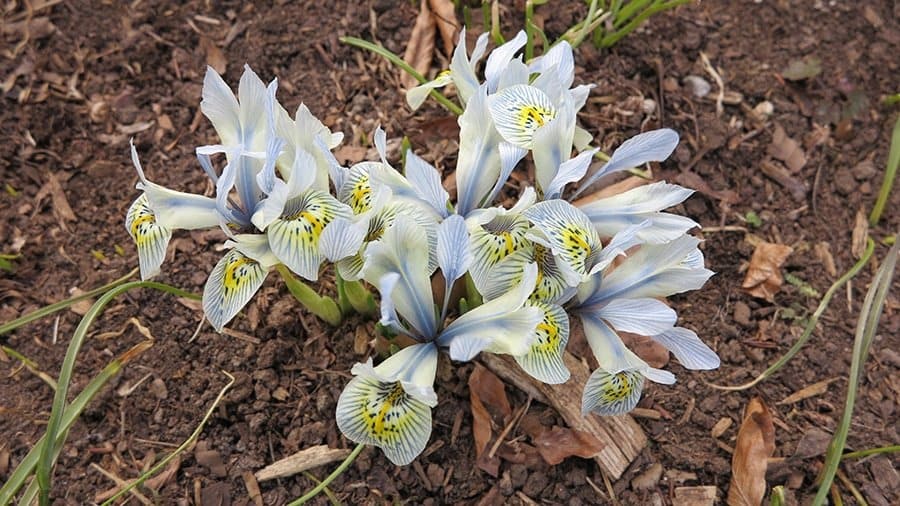
Short, early iris are lovely plants. I especially enjoy Iris reticulata and I. danfordiae, grown from small bulbs planted in autumn. These iris bloom in early spring, and several of mine make a pretty picture along the front walk. For someone who loves iris, these little bulbs are another way to start the season early, and provide an extended season of iris blooms. Their low-to-the-ground flowers stand on short stems only four inches (10 cm) tall, and bloom with the snowdrops and species crocus.
These iris seem to rise very quickly. One day there’s an empty space, and the next time you look – a bright cluster of iris blooms, their petals netted, spotted and blotched with contrasting colours. They make a stunning display when a dozen or so are planted thickly enough to form a cushion of flowers, but even five or six bulbs nestled into a little corner will certainly catch your eye.
Iris danfordiae is canary yellow with dark spots on the falls, and makes an exceptionally bright splash of colour. I. reticulata hybrids are shades of blue and purple with contrasting colour blotches, streaks and spots. ‘Clairette’ has light blue standards and dark blue falls with white markings. ‘Harmony’ is royal blue with white-rimmed gold cresting on each fall. ‘John Lonsdale’ is deep purple with almost black falls, each with a vivid gold streak. ‘George’ has narrow purple-violet petals with white streaks, while ‘Cantab’ is pale blue with a yellow blotch. Of the many named cultivars, the most unusual I’ve seen is ‘Katharine Hodgkin’ with wide ice-blue petals bearing dark blue netting and a yellow blotch with spots. Truly fabulous!
Although the flowers and stems of bulbous iris are short in stature, their foliage is disproportionately tall. The grass-like leaves rise up to 12 inches (30 cm) after the flowers are finished, and take about a month to ripen before finally turning brown. When the bulbs are planted in generous clusters, their foliage is sure to be noticed (particularly if it flops over, as can happen), and it makes sense to set them near other plants that will offer some camouflage. I find the foliage is easily concealed by rapidly growing daylily leaves and the expanding stems of epimedium, both of which begin growth in early spring.
Hardy to Zone 6, I. danfordiae and I. reticulata could possibly survive in Zone 5 if located close to a warm house foundation wall. They should be planted three inches (7.5 cm) deep and two to three inches (5 to 8 cm) apart. Like many spring-blooming bulbs, they prefer dry soil in summer. Iris bulbs return well the second year, but begin to dwindle out after that. When they send up foliage but no flowers, it’s time to remove them. The bulbs are reasonably priced, and it makes sense to plant some each fall to keep strong displays coming up in spring. When you see how lush and colourful these little iris are as they burst through the lingering snow, you’ll be eager for more.
